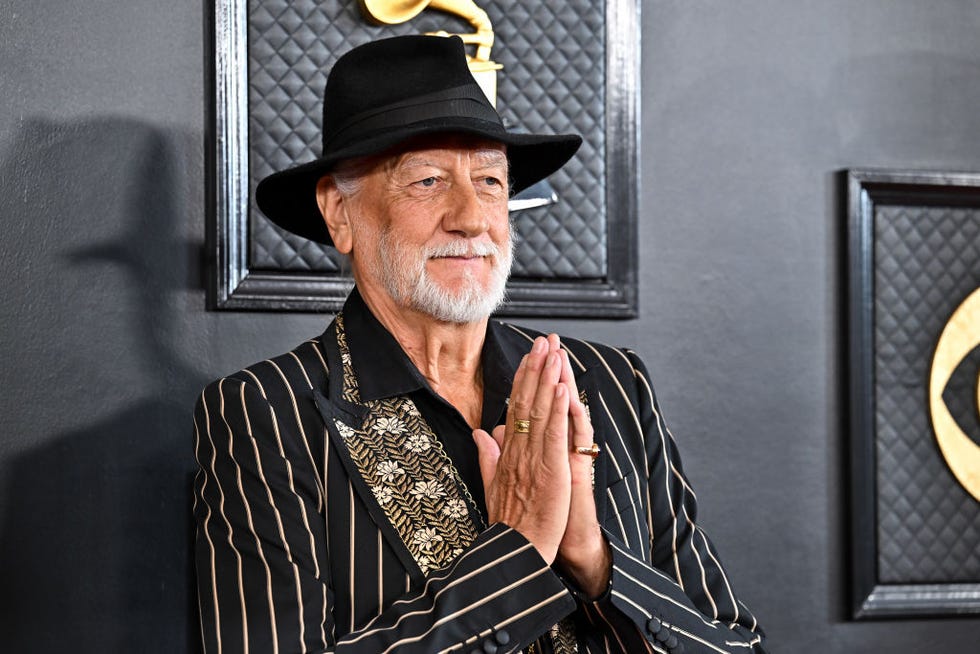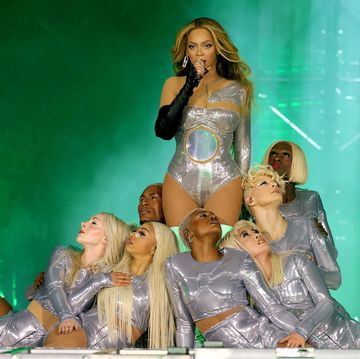Fleetwood Mac’s legacy was solidified with the 1977 release of Rumours. The album, which features hits like “Dreams” and “The Chain,” turned the band into bona fide rockstars. With over 40 million copies sold, Rumours is one of the highest-grossing albums of all time.
After Fleetwood Mac’s formation in 1967, constant lineup changes, crippling addictions, and tumultuous romances threatened to derail the group's success. With the additions of Christine McVie, Lindsey Buckingham, and Stevie Nicks, Fleetwood Mac spun inner discord into gold, creating breakup songs that would resonate with multiple generations of rock fans.
Over 50 years on, Fleetwood Mac’s music continues to capture the zeitgeist. After a 2020 TikTok featuring “Dreams” went viral, the fan-favorite track re-entered Billboard's Hot 100 chart, beating out Miley Cyrus and Lady Gaga for a spot in the top 40. Harry Styles’ friendship with Stevie Nicks has also delighted fans in recent years.
More From ELLE

Now, Amazon Studios’ Daisy Jones & The Six series could usher in the latest revival of Fleetwood Mac mania. Based on the novel by Taylor Jenkins Reid, the story follows a love triangle at the center of an iconic 1970s rock band—sound familiar? Reid cites Fleetwood Mac as the prime inspiration for her best-selling novel, which was published in 2019.
Whether or not you’re tuning into Daisy Jones, revisit the story of the real-life band that inspired the show below.
July 1967: Fleetwood Mac is founded in London, England.
The band’s original lineup consisted of drummer Mick Fleetwood, bassist John McVie, and vocalists/guitarists Jeremy Spencer and Peter Green. Danny Kirwan became the group’s third guitarist in 1968. That year, Fleetwood Mac released their self-titled debut album.
May 1970: The band loses its frontman.
Green quits Fleetwood Mac after a bad acid trip caused his mental health to deteriorate.
August 1970: Christine McVie joins Fleetwood Mac.
Two years after marrying John McVie, Christine, formerly of the band Chicken Shack, became a keyboardist and vocalist in his band. She was featured on Fleetwood Mac's fourth album, Kiln House, for which she also drew the cover art.
February 1971: Spencer leaves the band.
Before a sold-out show at the Whisky A Go Go, Spencer left to “get a magazine” and never returned. The band later discovered that Spencer joined a Christian cult known as The Family (formerly known as The Children of God). Bob Welch was hired as his replacement.
August 1972: Kirwan is fired from Fleetwood Mac.
Kirwan’s alcoholism strained his relationship with the band. After an explosive fight backstage led Kirwan to destroy his Les Paul guitar, he refused to perform and was promptly fired by Fleetwood. He was soon replaced by Bob Weston.
October 1973: Weston is fired after having an affair with Fleetwood's wife.
Fleetwood married Jenny Boyd in 1970. Her older sister, model Pattie Boyd, was George Harrison's then-wife and muse.
Boyd and Weston had an affair during Fleetwood Mac's tour promoting Mystery to Me. When Fleetwood found out, he was devastated; Weston was fired, and the rest of the tour was canceled. After completing their final show in Lincoln, Nebraska, the band temporarily split.
April 1974: A legal battle ensues over who owns Fleetwood Mac.
Fleetwood, the McVies, and Welch sued their former manager Clifford Davis in order to retain ownership of the Fleetwood Mac name. Davis was reportedly trying to use the name for another band in America.
“I think Davis thought we wouldn’t be bothered to fight his takeover,” Fleetwood told Rolling Stone at the time. He later added, “So many managers seem to forget who is employing who, and who makes the money. They forget it’s the people who bash the drums and twang the guitars.”
Davis, on the other hand, maintained that the name was his. “I want to get this out of the public's mind as far as the band being Mick Fleetwood's band,” he said. “This band has always been my band.”
September 1974: The original members of Fleetwood Mac reunite.
Fleetwood, the McVies, and Welch decided to relocate from England to the United States. After ditching Davis, the band didn’t replace him. Fleetwood Mac became the only major rock act to manage themselves, Rolling Stone reported at the time.
While the legal battle wasn’t over yet, they signed a new contract with Warner Bros. and released their ninth album, Heroes Are Hard to Find, as Fleetwood Mac. The suit was reportedly settled out of court four years later.
December 1974: Stevie Nicks and Lindsey Buckingham join the band.
Fleetwood visited Sound City Studios in Los Angeles. After Keith Olsen, a recording engineer, played Fleetwood “Frozen Love” by the duo Buckingham Nicks, he was captivated by their talent.
While at the studio, Fleetwood met Lindsey Buckingham and asked if he would join the band. Buckingham agreed on one condition: if his girlfriend, Stevie Nicks, could join too. They officially became apart of Fleetwood Mac on New Year's Eve 1974. Welch departed the group to pursue a solo career.
In 1975, Fleetwood Mac released their second self-titled album. It sold over half a million copies within the year, and it featured two major hits written by Nicks: “Landslide” and “Rhiannon.”
February 1976: Fleetwood Mac begins working on Rumours.
Despite the success of their latest album, stardom took its toll on the members of Fleetwood Mac. The McVies’ marriage dissolved, Buckingham and Nicks broke up, and Fleetwood struggled with drug use.
Meanwhile, the band was hard at work on Rumours. Personal turmoil fueled the album's production. The McVies only spoke to each other to discuss music, and Buckingham and Nicks penned soon-to-be hit singles “Dreams” and “Go Your Own Way” as digs at each other. Christine also began a romantic relationship with the band's lighting designer, Curry Grant. She wrote “You Make Loving Fun” about her new fling.
Rumours became Fleetwood Mac's most successful album. It charted at number one for over 30 weeks.
February 1977: The Rumours tour begins.
The band’s interpersonal drama continued as they headed out on a worldwide tour. Nicks fought with Buckingham after he mocked her on stage, and her cocaine habit became increasingly worse. Nicks’ addiction became more dangerous when a doctor discovered a dime-sized hole in her nasal cartilage big enough to cause a brain hemorrhage, which resulted from her putting aspirin dissolved in water up her nose to treat headaches.
Fleetwood briefly reconciled with Boyd—the couple remarried in 1977. Later that year, the drummer began an affair with Nicks. A Rolling Stone cover shoot the year prior, which featured the band all in bed together, “planted the seed,” according to Nicks. She and Fleetwood cuddle in bed in Annie Leibowitz's famous photograph. Fleetwood and Boyd divorced again in 1978.
1978: Fleetwood starts seeing Nicks’ friend.
In the midst of recording sessions for Tusk, Nicks discovered that Fleetwood started an affair with her good friend, Sara Recor. At the time, Recor was married to someone else.
“I lost Mick, which honestly wasn't that big of a deal because that was a rocky relationship,” said Nicks years later. “But losing my friend Sara? That was a huge blow. Sara was banished from the studio by the rest of the band ... No one was speaking, and I wouldn't even look directly at Mick. That went on for months. And it was great fodder for writing! The songs poured out of us.”
Fleetwood and Recor married in 1988 then divorced in 1995.
1980: Nicks and Buckingham fight on stage.
Buckingham and Nicks had long been broken up, but tension still existed between the former couple. During a Tusk tour concert in New Zealand, Buckingham tried to trip Nicks and even threw his guitar at her.
Nicks recalled to Rolling Stone that they “stopped the show” after the incident, and then a fight broke out backstage. “He went off, and we all ran at breakneck speed back to the dressing room to see who could kill him first. Christine got to him first, and then I got to him second–the bodyguards were trying to get in the middle of all of us.”
McVie recalled of standing up to Buckingham, “I think he’s the only person I ever, ever slapped.”
July 1981: Nicks launches her solo career.
Nicks released her debut solo album, Bella Donna, which contained hits like “Edge of Seventeen,” while still technically a member of Fleetwood Mac. Featuring collaborations with artists like Tom Petty and Don Henley of The Eagles, the album went number 1 on the Billboard 200 chart.
The title track, she told Rolling Stone, is “about making a lot of decisions in my life, making a change based on the turmoil in my soul.” She added, “I’m thirty-three years old, and my life has been very up and down in the last six years.”
March 1984: Fleetwood files for bankruptcy.
While many speculated that the drummer’s financial troubles stemmed from spending millions on drugs, ’s lawyer, Mickey Shapiro, denied this: “[Mick] is not in the classic sense a heavy roller. He’s not on the Beverly Hills Diet–champagne and cocaine.”
Late 1986: Nicks goes to rehab.
After finishing a solo tour, Nicks checked herself into Betty Ford to treat her cocaine addiction.
September 1987: Buckingham quits Fleetwood Mac.
Just ahead of their Tango in the Night tour, Buckingham announced he was leaving the band. He told Rolling Stone at the time that he intended to continue pursuing his solo career after producing the Tango in the Night album. “It was always our understanding that upon completion I would return to my solo work in progress,” he said.
With his exit, the group hired new guitarists Billy Burnette and Rick Vito.
September 1990: Nicks and Christine McVie leave Fleetwood Mac.
Nicks and McVie announced they would leave Fleetwood Mac at the end of their current tour, which would conclude in December that year. Nicks would go on to pursue her solo career, while McVie, according to the band’s publicist, would still record with Fleetwood Mac but no longer tour with them.
“The band had a series of very heartfelt conversations regarding the split-up,” publicist Mitchell Schneider said at the time. “Everybody is working together.”
But for Nicks, her exit reportedly stemmed from the track “Silver Springs.” The song was originally recorded for Rumours, but it didn’t end up making the album. Nicks planned on including the song on her 1991 greatest hits album, Timespace, but Fleetwood refused. Instead, he used it on 25 Years — The Chain, a two-disc box set released in 1992. This disagreement led to Nicks’ quitting the band.
January 1993: The band gets back together for Bill Clinton's inauguration.
Buckingham, Fleetwood, Nicks, and the McVies reunited to perform at Clinton’s inaugural ball.
That year, Nicks re-entered rehab, this time for a Klonopin addiction.
May-August 1997: Fleetwood Mac reunite on The Dance.
Recorded in May and released in August, The Dance was a live album from the group's reunion shows in Burbank, featuring Buckingham, Fleetwood, Nicks, and John and Christine McVie. The record marked their first release since Tango in the Night a decade earlier.
1998: Christine McVie leaves Fleetwood Mac.
“I think that I was probably just burned out when I left and I was frightened to fly,” she said, per People. But 16 years later, she returned in 2014 to tour with the band. By then she was living quietly in England after releasing some of her own solo music, but she missed being onstage.
“The truth of the matter is the only people I wanted to play with were the people I had played with all my life – these guys – Fleetwood Mac,” she said upon her return.
April 2018: Buckingham leaves Fleetwood Mac for the second time.
After rejoining in 1997, the guitarist and vocalist was fired from the band after a disagreement over touring commitments.
October 2018: Buckingham sues Fleetwood Mac.
Buckingham levied multiple charges against his former bandmates, including breach of fiduciary duty, breach of oral contract, and intentional interference with prospective economic advantage.
A representative for the band denied any wrongdoing. “Fleetwood Mac strongly disputes the allegations presented in Mr. Buckingham’s complaint and looks forward to their day in court,” they said.
The lawsuit was settled two months later, however, no details were publicly disclosed.
June 2022: Fleetwood Mac “kind of” break up.
In an interview with Rolling Stone, Christine discussed the possibility of a farewell tour. While the keyboardist said she didn't “feel physically up for it,” she shared her hopes for Buckingham’s return.
“I’d always want Lindsey back,” she said. “He’s the best."
Christine also revealed that Fleetwood Mac had unofficially split following their 2018/2019 world tour. “We’ve kind of broke up now, so I hardly ever see them,” she said of her fellow bandmates.
February 2023: Fleetwood says a reunion is off the table.
In November 2022, Christine McVie died at age 79 after suffering “a short illness.” Her family broke the news on social media.
Months later, Mick Fleetwood spoke to reporters at the 2023 Grammys. He said a Fleetwood Mac reunion was “unthinkable” following Christine’s death.
“I truly think the line in the sand has been drawn with the loss of Chris,” he explained. “I’d say we’re done, but then we’ve all said that before.”
That evening, Fleetwood performed a heartfelt tribute to Christine alongside Bonnie Raitt and Sheryl Crow.
Hannah Malach is an assistant producer at Hearst Magazines, where she covers entertainment news, the royals, and more for brands including Cosmopolitan, Elle, and Harper’s Bazaar. She’s previously written for Billboard, WWD, and The Hollywood Reporter. If she’s not catching up on the latest season of RuPaul’s Drag Race, you can probably find her curled up with a good book or exploring one of New York City’s many museums.



















